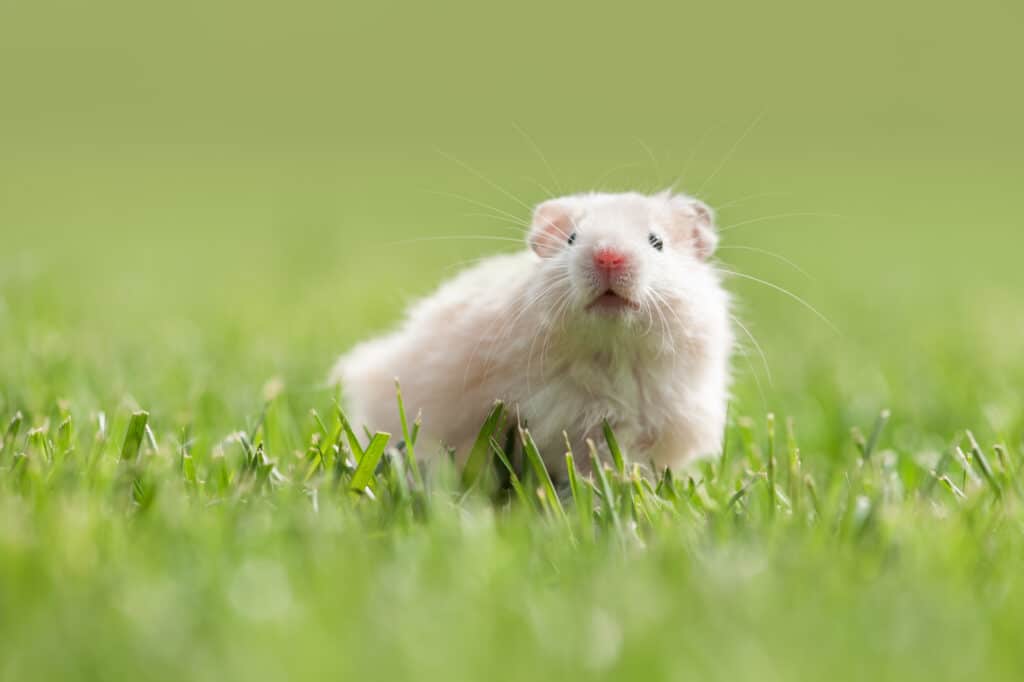Just like in humans, albinism is also present in hamsters. For the most part, albino hamsters are as healthy as normal hamsters. But they do have some health issues. In this blog post, find out what albino hamsters are, how to find out if a hamster is albino, what health issues albino hamsters are prone to, and how to take care of them properly.
What is an Albino Hamster?
A hamster that completely lacks the ability to make any pigment at all is called an albino hamster. Pigments (such as melanin) are coloring materials present in the hair, fur, eyes, and skin of animals. Some animals, like the chameleon, can change their color by moving pigments through specialized cells called chromatophores (Source: Physics Org).
Since albino hamsters cannot make any pigment at all, they have white coats, pink skin, and pink or red eyes. Now, you may think, “How can the eyes of an albino hamster be pink (or red) if they can’t produce pigments that give their eyes their color?” Factually speaking, the eyes of an albino hamster aren’t red; they are transparent. This makes the blood vessels in the eyes visible, making the eyes appear red.
What causes albinism in hamsters?
Each cell in a hamster contains thousands of genes, which are always present in pairs (1 gene in the pair is obtained from one parent and the other gene from the other parent). Each gene performs a function that can change when a mutation occurs in the gene. When this mutation occurs in a stem cell (cells that later become sperms and ova), the mutated gene is passed on to the offspring (More information about this in my blog post on hamster genetics).
For example, the Syrian hamster is normally golden-colored in the wild. The gene pair responsible for this color is denoted by the symbol BB. However, rust-colored Syrian hamsters contain a mutated form of this gene pair bb. Simply put, the functionality of the gene pair that codes for the golden color changes upon mutation, and it starts coding for the brown color instead of the golden color.
Similarly, there is a gene denoted by the symbol C (C for Color) in the body of animals. Using the information in this gene, an enzyme (protein) called tyrosinase is produced, which starts the transformation of the amino acid tyrosine into melanin pigment (Source: River Road Hamstery). So, if at least one of the genes in this gene pair is present in the original unmutated form (CC or Cc, where c is the mutated form of the gene C), the hamster will have the color that other gene pairs code for in his body. For example, if a hamster has the genes CC (or Cc) and BB, he could be golden in color; if he has the genes CC (or Cc) and bb, he could be rust-colored.
However, if both the genes in the above gene pair are mutated (cc), the hamster loses the ability to make any pigment at all. So, they have white fur, pink skin, and pink or red eyes. This is called true albinism and has only been observed in Campbell dwarf hamsters. It hasn’t been observed in other hamster species like the golden hamster or the Chinese hamster.
Are all albino hamsters white?
Yes, all albino hamsters have white fur, very pale skin, and red eyes because they do not have the ability to make any pigment.
Are all white hamsters albino?
No, not all white hamsters are albino. As explained above, true albinism has only been observed in Campbell dwarf hamsters. It hasn’t ever been recorded in other dwarf hamsters or the Syrian hamster.
But besides the mutation denoted by the symbol c, there are other mutations that can affect the tyrosinase (C) gene, which does not completely disable this gene’s ability to make pigments but only reduces it by varying degrees. The hamsters that are affected by these mutations can suffer from partial albinism. In addition to that, other genes can also affect pigment production to varying levels, leading to different forms of partial albinism.
Let’s take a look at some of these genes:
Acromelanic albinism – Dark-eared white
Denoted as cd, this mutated gene leads to partial albinism. This mutation removes coloration from all parts of the body of an animal except those that are below body temperature (only when the mutation is present in both genes of the corresponding gene pair – cdcd).
So, only the tail, nose, ears, and paws have color. But since hamsters have short tails, flat faces, and paws that are closer to their body, only their ears are ever at a lower temperature than the body temperature. So, only their ears have color. All other parts of their body are white.
Even though their ears are pale grey when they are young, the color darkens and eventually becomes black (Source: Nature). So these hamsters are called Dark-Eared White hamsters.
Fake albinism – flesh-eared white
In some ways, Cinnamon colored Syrian hamsters can be thought of as the complete opposites of Dark Eared Whites. The cinnamon gene (p – Not a mutation of the C gene, but a mutation of the P gene) prevents pigment formation only in the ears.
So, when a hamster has both the Cinnamon gene pair (pp) and the Dark-Eared White gene pair (cdcd), the Dark-Eared White gene prevents pigment formation everywhere except the ears, and the Cinnamon gene prevents pigment formation only in the ears. So, this hamster appears white all over and is called the Flesh-Eared White.
Defective albinism – Anopthalmic white
The term defective albinism was coined by me because this type of albinism creates congenital disorders in hamsters.
The gene responsible for this type of partial albinism is wh. The unmutated form of this gene is denoted as Wh. When only one of the genes in the gene pair is mutated (Whwh), it affects pigmentation and impacts the hearing ability of the hamster but may not cause complete deafness.
Loss of pigmentation is generally localized to the belly of hamsters. So this gene is called the White-bellied gene. Hamsters impacted by this gene have diluted coat color with a white belly.
However, when both the genes in the gene pair are mutated, the hamster lacks pigmentation totally, has profound hearing loss, and severe eye reduction. These hamsters are called Anophthalmic white hamsters (Source: Research Gate). So, ethical breeders will never breed two white-bellied gene hamsters intentionally.
How does true albinism affect hamsters?
In this section, let’s find out if true albinism negatively impacts hamsters and if they can be kept as pets.
Health effects
In humans, melanin is a pigment that acts both as a photoscreen and an antioxidant. As a photo screen, it absorbs light and UV radiation, thereby reducing the incidence of Age-related Macular Degeneration. As an antioxidant, it protects the eyes from the harmful effects of UV radiation. Thus, it reduces the risk of uveal melanoma, a type of cancer (Source: Wiley Library).
Since melanin gives pigmentation to hamsters’ eyes as well, the lack of melanin can make true albino hamsters more prone to these diseases when compared to normal hamsters.
Moreover, albino hamsters have reduced vision, especially bad depth perception. So, care should be taken to prevent these hamsters from falling. So, avoid Keeping raised platforms in the cage.
Melanin also protects the skin from the harmful effects of UV radiation, thereby reducing the incidence of skin cancer.
But besides these problems, albino hamsters have a lifespan similar to regular hamsters – Two years. However, Anopthalmic white hamsters have a significantly reduced lifespan – Only about nine months or so.
Behavior
Other than the aforementioned health effects, most albino hamsters are social with humans. So they can become good pets.



